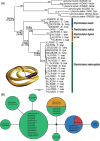An integrative systematic revision and biogeography of Rhynchocalamus snakes (Reptilia, Colubridae) with a description of a new species from Israel
- PMID: 28028461
- PMCID: PMC5183090
- DOI: 10.7717/peerj.2769
An integrative systematic revision and biogeography of Rhynchocalamus snakes (Reptilia, Colubridae) with a description of a new species from Israel
Abstract
Background: The colubrid snakes of the genus Rhynchocalamus are seldom studied and knowledge of their ecology and life history is scarce. Three species of Rhynchocalamus are currently recognized, R. satunini (from Turkey eastwards to Iran), R. arabicus (Yemen and Oman), and R. melanocephalus (from the Sinai Peninsula northwards to Turkey). All are slender, secretive, mainly nocturnal and rare fossorial snakes. This comprehensive study is the first to sample all known Rhynchocalamus species in order to review the intra-generic phylogenetic relationships and historical biogeography of the genus.
Methods: We revised the systematics of Rhynchocalamus using an integrative approach and evaluated its phylogeography. The phylogenetic position within the Colubridae and the phylogenetic relationships within the genus were inferred using 29 individuals belonging to the three known species, with additional sampling of two other closely-related genera, Muhtarophis and Lytorhynchus. We analysed three mitochondrial (12S, 16S, cytb) and one nuclear (c-mos) gene fragments. Phylogenetic trees were reconstructed using maximum likelihood and Bayesian inference methods; the latter method also used to provide the first time-calibrated molecular phylogeny of the genus. We generated a nuclear network and carried out a topology test and species delimitation analysis. Morphological comparisons were used to differentiate among species and to describe a new species from Israel. The studied material was comprised of 108 alcohol-preserved specimens, 15 photographs, and data from the literature for the examination of 17 mensural, 14 meristic, and two categorical characters.
Results: The molecular results support Rhynchocalamus as monophyletic, and as having split from its sister genus Lytorhynchus during the Late Oligocene. The three recognized species of Rhynchocalamus comprise four independently evolving groups. The molecular results reveal that the genus began to diverge during the Middle Miocene. We revealed that the best-studied species, R. melanocephalus, is paraphyletic. A population, formally ascribed to this species, from the Negev Mountain area in southern Israel is phylogenetically closer to R. arabicus from Oman than to the northern populations of the species from Israel, Syria and Turkey. Herein we describe this population as a new species: Rhynchocalamus dayanaesp. nov.
Discussion: We identify four species within Rhynchocalamus: R. satunini, R. arabicus, R. melanocephalus, and R. dayanaesp. nov., the latter, to the best of our knowledge, is endemic to southern Israel. The onset of Rhynchocalamus diversification is very old and estimated to have occurred during the Middle Miocene, possibly originating in the Levant region. Radiation probably resulted from vicariance and dispersal events caused by continuous geological instability, sea-level fluctuations and climatic changes within the Levant region.
Keywords: Arabia; Diversification; Evolution; Middle east; Phylogeny; Phylogeography; Reptiles; Taxonomy.
Conflict of interest statement
The authors declare there are no competing interests.
Figures






References
-
- Amr ZS, Disi AM. Systematics, distribution and ecology of the snakes of Jordan. Vertebrate Zoology. 2011;61:179–266.
-
- Amr ZS, Egan DM, Nilson G, Kumlutaş Y, Baha El Din S, Sadek R, Lymberakis P, Ugurtas IH, Werner YL, Tok V, Sevinç M, Hraoui-Bloquet S, Crochet PA, Kaska Y, Avci A. Rhynchocalamus melanocephalus. The IUCN red list of threatened species 2012. 2012. e.T164637A1062839.
-
- Ananjeva NB, Orlov NL, Khalikov RG, Darevsky IS, Ryabov IS, Barabanov AV. The Reptiles of North Eurasia. Taxonomic diversity, distribution, conservation status [this comprises the territory of the former Soviet Union and Mongolia] Sofia: Pensoft Series; 2006.
-
- Araújo MB, Pearson RG, Thuiller W, Erhard M. Validation of species-climate impact models under climate change. Global Change Biology. 2005;11:1504–1513. doi: 10.1111/j.1365-2486.2005.01000.x. - DOI
-
- Arbel A. Encyclopedia of plants and animals of the land of Israel. Ministry of Defence Press; Tel-Aviv: 1984. Reptiles and amphibians.
LinkOut - more resources
Full Text Sources
Other Literature Sources

